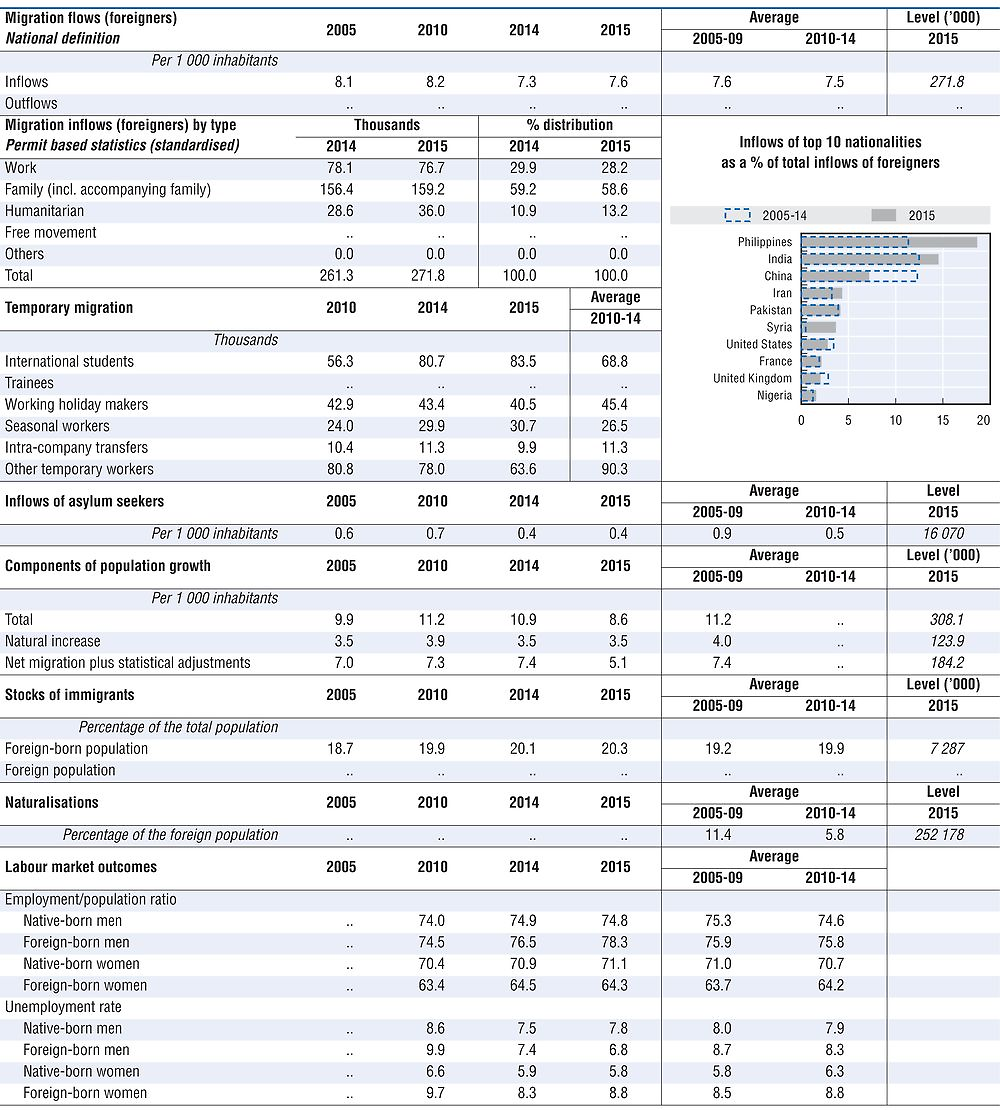Canada
In 2015, almost 272 000 foreign nationals were granted permanent resident status in Canada, the highest admissions level since 2010 and within the planned range in the 2015 immigration levels plan. Economic category admissions in 2015 increased by 3% compared with 2014, to more than 170 000 (including accompanying family). Of this number, 70 100 were admitted under the skilled worker programme – slightly more than in 2014. The provincial nominee programme was the second largest group at 44 500 admissions, down from 47 600 in 2014. Caregivers continued to be the third largest group under the economic category, with admissions of 27 200 in 2015.
The biggest increase in permanent migration – both in absolute numbers and proportion – was in the refugee and protected persons category, which saw over 58 000 overall admissions in 2016, up from 31 500 in 2015, and 23 300 in 2014. This is mainly in response to the Syrian refugee crisis: Canada resettled more than 40 000 Syrian refugees between November 2015 and January 2017, of whom 25 000 were already resettled by the end of Feburary 2016. Canada also continued to resettle other refugees from around the world as part of a multiyear commitment. In total, Canada resettled over 46 000 refugees in 2016. In 2017, the planned range for the refugee and protected persons category is 33 000 to 40 000, which is higher than previous years before Operation Syrian Refugees in 2016.
In 2016, a number of policy initiatives aimed at facilitating family migration were introduced. Nearly 61 000 spouses, partners and dependent children were admitted in 2016 within the planned range, compared to 50 000 admissions in 2015. In February 2016, the cap on applications for sponsorship of parents and grandparents in 2016 was doubled from 5 000 to 10 000, in order to reunite more families. Over 17 000 parents and grandparents were admitted in 2016. The 2017 planning range for family immgrants is 80 000 to 86 000, which is higher than previous years. In parallel, efforts were undertaken to shorten processing times and reduce backlog in applications for family migration.
As the first major overhaul of the Express Entry system since its introduction in early 2015, important changes were made in November 2016 to include better aligning requirements to receive job offer points with Canadian labour market realities and awarding additional points to international students who completed their studies in Canada. In contrast, the number of points available for a job offer has been significantly reduced. In addition, more time is allocated to candidates to submit an application for permanent residence once an invitation to apply is received.
A total of 281 000 temporary residents had initial permits in 2015 (a person may have more than one initial work and study permit in a year), which is a 5% decline from 2014. Of these, 157 700 were work permit holders. More than 126 700 students had their initial permits in 2015, which is an increase of 4% over 2014, and almost twice the number in 2006. One in four of those students came from China, and one in five from India.
In contrast to students, the number of temporary migrants with initial work permits declined in 2015. Initial permit holder numbers dropped in 2014, following a Temporary Foreign Worker programme review, and 2015 saw a further 38% drop, to over 20 500. A Canadian parliamentary committee in September 2016 recommended a number of further changes. As part of the government’s initial response, in December 2016, the previous four-year maximum cumulative duration for certain types of temporary foreign workers will no longer apply. Canada’s Global Skills Strategy, first announced in November 2016 and officially launched in March 2017, will help attract global investment and highly-skilled workers to start or expand businesses in Canada and create new Canadian jobs.
Immigration continues to be key in supporting the Government of Canada’s priorities to strengthen the country’s economy and middle class in 2016 and 2017. A historically-high planned target of 300 000 new permanent residents to be admitted to Canada has been set for 2017, and top skills and talent from around the world are being attracted to help grow innovative businesses. These objectives are balanced with maintaining Canada’s commitment to offering protection to the displaced and persecuted and focusing on improving family reunification.

